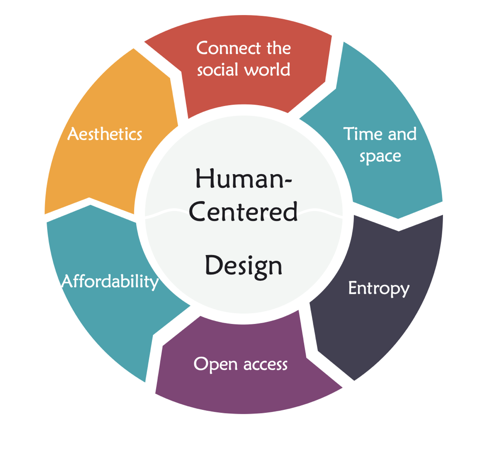
Welcome back. This blog is the last in my series detailing the barriers to the adoption of ‘tiny homes’ and ‘tiny communities’ in the US. In this issue, I focus on the practical – how to get it done. For those of you just tuning in Part 1, I discussed the background of the problem. Part 2 outlined the planning and zoning regulation advances I see to overcome innovation resistance.
The Future
So, where do we go? If, as I have suggested in this blog series, ‘tiny homes (ADUs) and resultant intentional communities can address what has been termed ‘the missing middle’ housing issue, then what are some specific design criteria that cities, towns, and communities should consider?
In the interests of brevity, I won’t go into technical details here. Interested readers should refer to my “The Digital Workplace” and a technical article published in Proceedings of the ACM SIG on Computer Personnel Research,
Six Principles of Future Ready Urban Design
These principles are borrowed from socio-technical theory and modified by my own experience. The underlying philosophy, of course, is to design PLACES to support the healthy functioning of a community over time. These six design principles are:

1. The layout of living spaces must prioritize connection and openness. A spatial arrangement that restricts, inhibits, or disconnects people from each other goes against this principle.
2. Creating connections in space involves ensuring that different parts of the community relate in time and space. The community must have a sense of history while planning for the future.
3. Designing against entropy means creating components that work against the natural tendency for systems to break down. Procedures should be constructed to guard against this tendency and avoid spreading disinformation.
4. Open access is a crucial aspect that designers must consider. Determining what is public and what is private and how to signify it is an important decision. Emphasizing open access embeds social values into system design.
5. The affordability of a community is vital. Overpriced systems may fail in the market, regardless of their functionality. However, perceived value is also influenced by factors beyond just price. The effectiveness of a system in actual use can significantly impact its perceived value.
6. Technology systems should also strive for aesthetic appeal. Aesthetics, or the study of art and beauty, plays a significant role in Design. Simplicity, elegance, and grace are essential qualities. Aesthetically pleasing designs attract users and reflect the uniqueness and purpose of the designer or company behind them.
Wrapping Up
So there you have it. We need more accessible and affordable housing. Many administrative barriers exist. Moreover, we need a non-traditional set of design principles if ‘tiny homes’ or Accessory Dwelling Units (ADUs) are going to be part of the answer. I am making the case that these principles should be taken from the human-centered design process. Borrowing from past research on computer system design, I have presented an initial set of first principles.
As I close this series out, there is good news to report. AARP launched a Community Challenge grant program last Spring. One of the programs focuses on a design competition for Accessory Dwelling Units (ADUs). Here in Tucson, 60 individual submissions were presented to the community. Fifteen other cities are also participating. A review group is now evaluating those proposals. I’ll post the summary results when they are made public early next year.
I hope you found this short series interesting, informative, and entertaining. There will be one more blog this year where I will announce my focus areas and projects for 2024. Until let’s celebrate. Take us out, Tanika:


Leave A Comment
You must be logged in to post a comment.